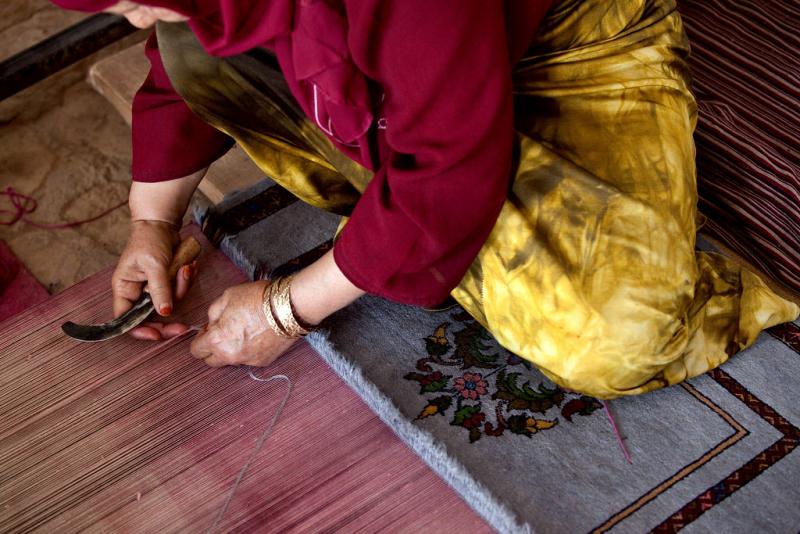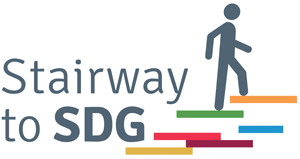Introduction

Shirin, works at weaving a carpet (by World Bank Photo Collection is licensed under CC BY-NC-ND 2.0)
Ending poverty in all its forms everywhere is the first goal of the 2030 Agenda for Sustainable Development with the aim of ensuring social protection, improving access to basic services and building resilience to the effects of natural disasters.
1.3 billion people in 107 developing countries, representing 22 percent of the world’s population, live in multidimensional poverty. Of all children living in extreme poverty, 75 per cent live in sub-Saharan Africa and Asia.
Poverty is defined as being poor and lacking access to adequate needs: those who suffer from poverty also do not have access to social welfare instruments such as education and health needs.
The aim of this activity is for the students to analyse their socio-cultural origin, in relation to the future position of work they can aspire to, and to compare it with the different conditions and quality of life of other populations that are more or less developed, thus making students understand that the issue of poverty has different facets that include social, economical and political elements.
The activity also proposes two calls to action: one aimed at the direct knowledge of one or more people from one of the countries analyzed in order to analyze the phenomenon in a deeper way, and the other aimed at the creation of a fund-raising campaign for organisations/people with socio-economic difficulties.
Learning Objectives
- The learner knows about the local, national and global distribution of extreme poverty and extreme wealth.
- The learner is able to show sensitivity to the issues of poverty as well as empathy and solidarity with poor people and those in vulnerable situations.
- The learner is able to identify their personal experiences and biases with respect to poverty.
- The learner is able to plan, implement, evaluate and replicate activities that contribute to poverty reduction.
- Anticipatory competency
- Strategic competency
- Self awareness competency
Instructions
Step 1) Introduction (30 minutes)
We introduce the issue of poverty, with some simple questions ( What is poverty for you? How many types of poverty do you know? What does it depend on? Do you think that poverty is a dynamic or static phenomenon?) To show students that poverty is a dynamic phenomenon, the teacher can project the introductory video (PIB Latinoamerica) showing the variation in the GDP of different countries in recent years and their future projections.
After viewing the video the teacher will briefly introduce some facts about the first goal of sustainable development (the professors can draw inspiration from Websites to explain SDG1)
Step 2) Situating ourselves at the socio-economic level of our environment (60 minutes)
In this part the students will realize a study about the job that they will do at the end of their studies, comparing it to the datas/information of the same job but in a different part of the world.
The students will analyse datas such as:
- Salary
- Age of entry into the labour market
- Age of emancipation
- Age of first child (and average number of children per family)
- Retirement age
- Life expectancy
After finding these data on the website (Useful Resources) , or look at Call to Action 1, the students completethese tables to have a global view of the lifestyle of each country, not only with respect to income but also the cost and conditions of living.
Step 3) Graphics (60 minutes)
Students will report the data found in the graphics (Graphic_ Food/ Graphic_Age) in order to compare for each selected item the value of the country in which they live compared to another country, and analyze their situation by comparing, when possible, income to the cost of living. It is recommended that before starting, a value is marked for each square of the proposed graph.
Step 4) Final reflection (20 minutes)
Once the graph is finished, the teacher will start a reflection with the students based on the data obtained, starting from the following questions:
- Take the data of the worst country in the world.
- What do you think your life would be like? What would you be doing?
- Would you be studying?
- Would you have a child? How long would it be before you have a child?
- How much would you earn if you were working as an apprentice in your training cycle?
- Now, take the data of the price chart.
- What do you think is the reason for the price disparity in some products?
- According to the income relationship, do you think there is a price, in any country that is "unjust"?
- What do you think this inequality/ price injustice stems from?
- In which country do you think you live better if you earn...? And why?
a) €300/month
b) 1000 €/month
c) €10,000/month
d) €100,000/month
- In which country would you live better if you found a job related to your training cycle? And why?
- What would you choose between these two options? And why? (assuming that prices did not change and current conditions were maintained)
- Earn 1500€ every month and everyone earns 1000€
- Earn 2000€ and the rest earns 3000€
- CALL TO ACTION 1
Students will be asked to contact persons playing the same professional role in other countries of the world to compare their future employment situation with that of a more or less developed reality than the country to which they belong (the countries may be the same as those analysed during the activity).
Contact with these people can be made through a personal knowledge network, through the use of social networks or through contact with volunteer associations that help establish a connection with these people.
The interview may be conducted through a video call via Skype or through the exchange of emails.
The questions that students can ask to the interviewees are about working conditions, working hours, worker protection, the cost of living of the country in relation to the salary received, training received, socio-cultural background, unemployment rate, etc.
At the end of the activity, students will be able to transcribe the interview and disseminate the data they found on the website of their school, or by creating a brochure in order to raise students' awareness of their working conditions in other countries of the world that are more or less developed than where they live.
- CALL TO ACTION 2
Students will be asked to initiate a fundraiser through the website, a free platform that allows them to create fundraising campaigns of various types, targeting individuals, groups and organizations. All you have to do to start a new campaign is create your account on the web site, tell your story and set the goal for fundraising.
Fund-raising may be directed to an NGO or an organisation to assist people who are performing a job function similar to that of the vocational training of the students but in an underdeveloped country.
After deciding on who to allocate the funds to, the class will register itself on the site explaining the motivation for the fundraising, what the funds will be used for, when they are needed, who will benefit from it, and all the information that may be useful to donors.
Then, the initiative will be shared at your school, with friends and family to collect the first donations that will go to the project in question.







